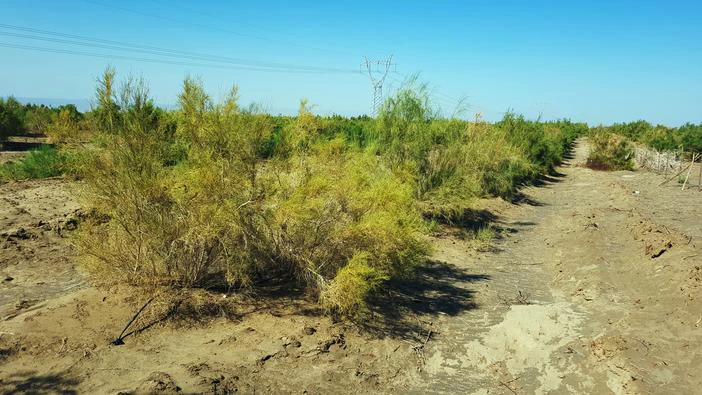Saxaul
(Haloxylon ammodendron)
Saxaul (Haloxylon ammodendron)
/
/

Anagoria
CC BY-SA 4.0
Image By:
Anagoria
Recorded By:
Copyright:
CC BY-SA 4.0
Copyright Notice:
Photo by: Anagoria | License Type: CC BY-SA 4.0 | License URL: https://creativecommons.org/licenses/by-sa/4.0 | Uploader: Anagoria | Publisher: Wikipedia Commons
















Estimated Native Range
Climate Requirements for Richmond, Virginia
| This Plant | Your Site | Plant Suitability for Your Location | ||
|---|---|---|---|---|
| • Precipitation | 1" - 14" | 43" | Aquatic | Aquatic |
| • High Temp. | 41°F - 107°F | 90°F | Your summer temperatures are normal for this plant. | Excellent |
| • Low Temp. | -26°F - 43°F | 27°F | Your winter temperatures are normal for this plant | Excellent |
This plant may not grow well at your location - your precipitation is too high.
Summary
Haloxylon ammodendron, commonly known as Saxaul, is an evergreen shrub or small tree native to the deserts and semi-deserts of Central Asia, particularly in areas with saline and sandy soils. It typically ranges in size from 2 to 8 meters tall, and occasionally reaches up to 12 meters. The Saxaul has a distinctive brown trunk up to 10 inches (25 cm) in diameter, with heavy, coarse wood and spongy, water-soaked bark. Its branches are green when young, maturing to brown, grey, or white. The plant’s leaves are reduced to tiny, cusp-like scales, giving it an almost leafless appearance. The inflorescences are short lateral shoots on the previous year’s stems, with very small flowers that are either bisexual or male, and are as long or shorter than the bracteoles. Saxaul blooms from March to April, and its fruiting period extends from October to November, producing winged fruit about 8 mm in diameter with a 1.5 mm seed.
Saxaul is highly valued for its exceptional drought resistance, making it an important species for establishing shelter belts and stabilizing sand dunes to combat desertification. It thrives in full sun and can tolerate low to medium water availability, preferring soils with fast or medium drainage. In cultivation, it is used for xeriscaping and as an ornamental plant in arid landscapes. Its ability to grow in harsh conditions with minimal care makes it a practical choice for challenging environments.CC BY-SA 4.0
Saxaul is highly valued for its exceptional drought resistance, making it an important species for establishing shelter belts and stabilizing sand dunes to combat desertification. It thrives in full sun and can tolerate low to medium water availability, preferring soils with fast or medium drainage. In cultivation, it is used for xeriscaping and as an ornamental plant in arid landscapes. Its ability to grow in harsh conditions with minimal care makes it a practical choice for challenging environments.CC BY-SA 4.0
Plant Description
- Plant Type: Shrub
- Height: 4-6.5 feet
- Width: 1-2.5 feet
- Growth Rate: Slow
- Flower Color: N/A
- Flowering Season: Spring, Summer
- Leaf Retention: Evergreen
Growth Requirements
- Sun: Full Sun
- Water: Low, Medium
- Drainage: Fast, Medium
Common Uses
Drought Tolerant, Erosion Control, Low Maintenance
Natural Habitat
Native to the deserts and semi-deserts of Central Asia, particularly in areas with saline and sandy soils
Other Names
Common Names: Black Saxaul, Sacsaoul, Saksaul
Scientific Names: Haloxylon ammodendron, Haloxylon aphyllum, Anabasis ammodendron, Arthrophytum ammodendron, Anabasis saxaul, Arthrophytum ammodendron var. aphyllum, Arthrophytum haloxylon, Haloxylon ammodendron var. aphyllum, Haloxylon pachycladum
GBIF Accepted Name: Haloxylon ammodendron (C.A.Mey.) Bunge ex Fenzl